


 
 
 
 Photo Essay: A Shropshire WalkFirst posted in December, 2004 Photo Essay: A Shropshire WalkFirst posted in December, 2004
On most of the days where weather has allowed us to do so during our stay in Shropshire, Sam and I have been venturing out for a walk "around the block." This consists not of the walk I took the other day to Bishop's Castle, which leads to tarmac and pavement and shops filled with books, but on a circuit through the local fields, across which are designated rights of way for public access.
 |
 he landscape around Bishop's Castle is composed of small, rolling hills. Were they forested I doubt they'd seem so expansive and impressive, but cleared into fields that stretch on and on to the horizon... well, for some reason I have taken countless photographs of this hill in particular, and I stop to admire it every time without fail, regardless of whether or not I have a camera on my person.
Yesterday, my dear friend Kirsten accompanied Sam and I on this walk, and she was the only one with a camera; I was pleased that this hill was one of the things she made a point of capturing with the limited space on her digital camera. Unfortunately, she was not so fortunate as to have lounging cattle in the foreground. he landscape around Bishop's Castle is composed of small, rolling hills. Were they forested I doubt they'd seem so expansive and impressive, but cleared into fields that stretch on and on to the horizon... well, for some reason I have taken countless photographs of this hill in particular, and I stop to admire it every time without fail, regardless of whether or not I have a camera on my person.
Yesterday, my dear friend Kirsten accompanied Sam and I on this walk, and she was the only one with a camera; I was pleased that this hill was one of the things she made a point of capturing with the limited space on her digital camera. Unfortunately, she was not so fortunate as to have lounging cattle in the foreground. |
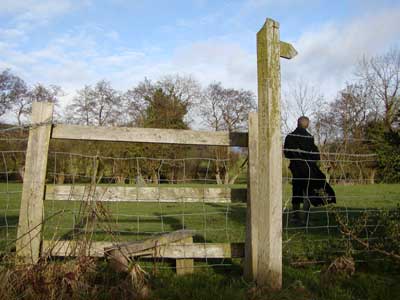 |  here really aren't hiking trails or foot paths, per se, but public rights of way have been maintained for walking across privately owned farmsteads and fields. The lane on which Field's Cottage sits is a popular right of way, for instance, and during this holiday week I've seen as many as five groups stroll past the cottage in an hour. (Speak of the devil, one has just walked past the window of the study.)
From the road, the right of way begins crossing fields, many of which contain livestock, primarily cattle or sheep. Obviously it would be bad business for all of those hikers to be opening and closing gates, possibly not securing them properly, and so instead you have to cross little stiles that put you over the fence and into the field. Here, Sam has just crossed a stile - the little board that appears to be wedged through the fence at the bottom center of this photograph; it's supported by a post on each side for stability, and gives you just enough height to swing a leg over the fence. A sign points you toward the next stile. here really aren't hiking trails or foot paths, per se, but public rights of way have been maintained for walking across privately owned farmsteads and fields. The lane on which Field's Cottage sits is a popular right of way, for instance, and during this holiday week I've seen as many as five groups stroll past the cottage in an hour. (Speak of the devil, one has just walked past the window of the study.)
From the road, the right of way begins crossing fields, many of which contain livestock, primarily cattle or sheep. Obviously it would be bad business for all of those hikers to be opening and closing gates, possibly not securing them properly, and so instead you have to cross little stiles that put you over the fence and into the field. Here, Sam has just crossed a stile - the little board that appears to be wedged through the fence at the bottom center of this photograph; it's supported by a post on each side for stability, and gives you just enough height to swing a leg over the fence. A sign points you toward the next stile. |
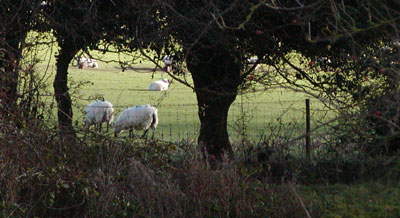 |  have been quite enamored as of late with the silhouetting of trees against landscapes and/or the sky. Here, sheep are grazing in the next field, framed by vegetation. have been quite enamored as of late with the silhouetting of trees against landscapes and/or the sky. Here, sheep are grazing in the next field, framed by vegetation. |
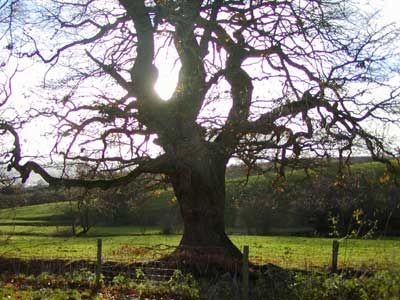 |  imilarly, I could not resist taking a photograph (well, several, but this was the one that came closest to working) of the sun shining through the branches of this gnarled old oak. imilarly, I could not resist taking a photograph (well, several, but this was the one that came closest to working) of the sun shining through the branches of this gnarled old oak. |
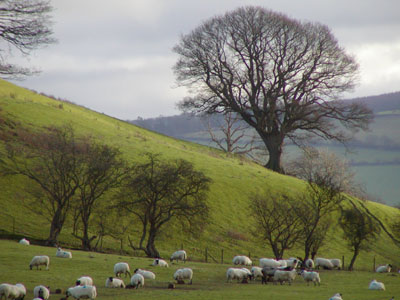 |  s previously mentioned, Shropshire hiking takes you through fields of livestock. I took this photograph just before approaching a herd of sheep. The reason there are no photographs physically amongst the sheep is because they are pathetically skittish and run as you approach. I have a few photographs of sheep stampedes, but unfortunately none capture the true drama of the event, and thus I cannot bring myself to post them. s previously mentioned, Shropshire hiking takes you through fields of livestock. I took this photograph just before approaching a herd of sheep. The reason there are no photographs physically amongst the sheep is because they are pathetically skittish and run as you approach. I have a few photographs of sheep stampedes, but unfortunately none capture the true drama of the event, and thus I cannot bring myself to post them. |
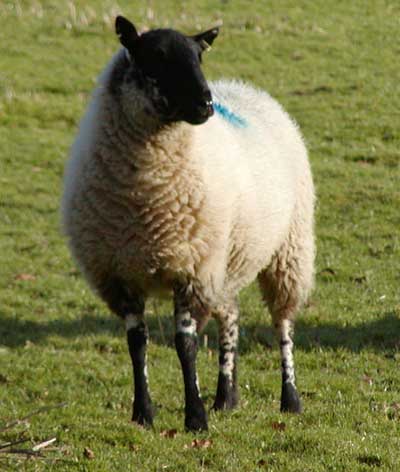 |  was, however, able to capture this sheep on "film" through sneaky employment of my optical zoom. You can tell that I am using my zoom and am actually rather far away from this sheep by looking closely and seeing that it is not panicked, nor is it running away, but rather contemplating what to do next from a vast array of choices that probably include, and are limited to, eating, sleeping, baaing, using the loo, or trying to figure out what to name its lamb when the time comes (though probably not this last one - not because the ewe isn't with lamb, but because I don't afford sheep the ability to think beyond their basic instinctual needs).
Which brings me to the large blue spot on this ewe's back. I originally thought that the farmers allow their herds to mingle and rotate fields among a farmers' collective or some such, but it turns out that the blue patch on her back was actually left there by a randy ram. The farmer puts a colored dye on the front of a ram, releases it into the field of ewes, and any encounters are marked by a transfer of this dye from the chest of the ram to the back of the ewe. Thus, the farmer can see which ewes need to be examined and, if they are indeed found to be pregnant, which ram provided the genes. was, however, able to capture this sheep on "film" through sneaky employment of my optical zoom. You can tell that I am using my zoom and am actually rather far away from this sheep by looking closely and seeing that it is not panicked, nor is it running away, but rather contemplating what to do next from a vast array of choices that probably include, and are limited to, eating, sleeping, baaing, using the loo, or trying to figure out what to name its lamb when the time comes (though probably not this last one - not because the ewe isn't with lamb, but because I don't afford sheep the ability to think beyond their basic instinctual needs).
Which brings me to the large blue spot on this ewe's back. I originally thought that the farmers allow their herds to mingle and rotate fields among a farmers' collective or some such, but it turns out that the blue patch on her back was actually left there by a randy ram. The farmer puts a colored dye on the front of a ram, releases it into the field of ewes, and any encounters are marked by a transfer of this dye from the chest of the ram to the back of the ewe. Thus, the farmer can see which ewes need to be examined and, if they are indeed found to be pregnant, which ram provided the genes. |
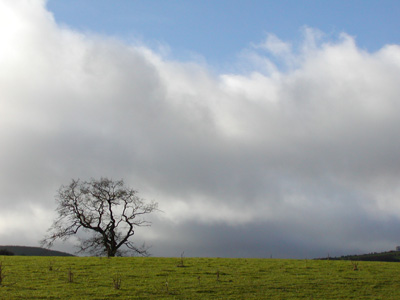 |  ne final tree silhouette. This is by no means a remarkable photograph, but I love how so many trees have been spared in the center of fields, often just at the ridge line.
While I do not, on the whole, approve of the way in which England has denuded so much of its lovely landscape, I recognize that there is still profound beauty to be found in it, as evidenced by the many wonderful photography subjects I have encountered thus far.
Additionally, after so many hundreds of years of habitation by so many people in such a small place, it is difficult to discern how there are indeed any trees left at all. This hike actually ventures into the woods for a short distance, but photographs from that portion of the walk are not included here; the eye is often infinitely better at capturing the mood from within a wood than is a camera, and therefore photographs are generally a disappointment, particularly in winter.
From an ecological perspective, I think we've only in the past century or so come to realize how very important untouched landscapes can be, although I suppose such landscapes have always touched the hearts of those who appreciate natural beauty.
And here is where my aimless thoughts on managed land use and sharing of photographs shall cease, for there are other things to do this evening. More photographs to come, to be shared publicly if people continue to find them to be of some interest. ne final tree silhouette. This is by no means a remarkable photograph, but I love how so many trees have been spared in the center of fields, often just at the ridge line.
While I do not, on the whole, approve of the way in which England has denuded so much of its lovely landscape, I recognize that there is still profound beauty to be found in it, as evidenced by the many wonderful photography subjects I have encountered thus far.
Additionally, after so many hundreds of years of habitation by so many people in such a small place, it is difficult to discern how there are indeed any trees left at all. This hike actually ventures into the woods for a short distance, but photographs from that portion of the walk are not included here; the eye is often infinitely better at capturing the mood from within a wood than is a camera, and therefore photographs are generally a disappointment, particularly in winter.
From an ecological perspective, I think we've only in the past century or so come to realize how very important untouched landscapes can be, although I suppose such landscapes have always touched the hearts of those who appreciate natural beauty.
And here is where my aimless thoughts on managed land use and sharing of photographs shall cease, for there are other things to do this evening. More photographs to come, to be shared publicly if people continue to find them to be of some interest. |
[ TOP OF THIS PAGE | MORE PHOTOGRAPHY | MORE WRITING | HOME ]


|






 he landscape around Bishop's Castle is composed of small, rolling hills. Were they forested I doubt they'd seem so expansive and impressive, but cleared into fields that stretch on and on to the horizon... well, for some reason I have taken countless photographs of this hill in particular, and I stop to admire it every time without fail, regardless of whether or not I have a camera on my person.
Yesterday, my dear friend Kirsten accompanied Sam and I on this walk, and she was the only one with a camera; I was pleased that this hill was one of the things she made a point of capturing with the limited space on her digital camera. Unfortunately, she was not so fortunate as to have lounging cattle in the foreground.
he landscape around Bishop's Castle is composed of small, rolling hills. Were they forested I doubt they'd seem so expansive and impressive, but cleared into fields that stretch on and on to the horizon... well, for some reason I have taken countless photographs of this hill in particular, and I stop to admire it every time without fail, regardless of whether or not I have a camera on my person.
Yesterday, my dear friend Kirsten accompanied Sam and I on this walk, and she was the only one with a camera; I was pleased that this hill was one of the things she made a point of capturing with the limited space on her digital camera. Unfortunately, she was not so fortunate as to have lounging cattle in the foreground.

 have been quite enamored as of late with the silhouetting of trees against landscapes and/or the sky. Here, sheep are grazing in the next field, framed by vegetation.
have been quite enamored as of late with the silhouetting of trees against landscapes and/or the sky. Here, sheep are grazing in the next field, framed by vegetation.
 imilarly, I could not resist taking a photograph (well, several, but this was the one that came closest to working) of the sun shining through the branches of this gnarled old oak.
imilarly, I could not resist taking a photograph (well, several, but this was the one that came closest to working) of the sun shining through the branches of this gnarled old oak.
 s previously mentioned, Shropshire hiking takes you through fields of livestock. I took this photograph just before approaching a herd of sheep. The reason there are no photographs physically amongst the sheep is because they are pathetically skittish and run as you approach. I have a few photographs of sheep stampedes, but unfortunately none capture the true drama of the event, and thus I cannot bring myself to post them.
s previously mentioned, Shropshire hiking takes you through fields of livestock. I took this photograph just before approaching a herd of sheep. The reason there are no photographs physically amongst the sheep is because they are pathetically skittish and run as you approach. I have a few photographs of sheep stampedes, but unfortunately none capture the true drama of the event, and thus I cannot bring myself to post them.

 ne final tree silhouette. This is by no means a remarkable photograph, but I love how so many trees have been spared in the center of fields, often just at the ridge line.
While I do not, on the whole, approve of the way in which England has denuded so much of its lovely landscape, I recognize that there is still profound beauty to be found in it, as evidenced by the many wonderful photography subjects I have encountered thus far.
Additionally, after so many hundreds of years of habitation by so many people in such a small place, it is difficult to discern how there are indeed any trees left at all. This hike actually ventures into the woods for a short distance, but photographs from that portion of the walk are not included here; the eye is often infinitely better at capturing the mood from within a wood than is a camera, and therefore photographs are generally a disappointment, particularly in winter.
From an ecological perspective, I think we've only in the past century or so come to realize how very important untouched landscapes can be, although I suppose such landscapes have always touched the hearts of those who appreciate natural beauty.
And here is where my aimless thoughts on managed land use and sharing of photographs shall cease, for there are other things to do this evening. More photographs to come, to be shared publicly if people continue to find them to be of some interest.
ne final tree silhouette. This is by no means a remarkable photograph, but I love how so many trees have been spared in the center of fields, often just at the ridge line.
While I do not, on the whole, approve of the way in which England has denuded so much of its lovely landscape, I recognize that there is still profound beauty to be found in it, as evidenced by the many wonderful photography subjects I have encountered thus far.
Additionally, after so many hundreds of years of habitation by so many people in such a small place, it is difficult to discern how there are indeed any trees left at all. This hike actually ventures into the woods for a short distance, but photographs from that portion of the walk are not included here; the eye is often infinitely better at capturing the mood from within a wood than is a camera, and therefore photographs are generally a disappointment, particularly in winter.
From an ecological perspective, I think we've only in the past century or so come to realize how very important untouched landscapes can be, although I suppose such landscapes have always touched the hearts of those who appreciate natural beauty.
And here is where my aimless thoughts on managed land use and sharing of photographs shall cease, for there are other things to do this evening. More photographs to come, to be shared publicly if people continue to find them to be of some interest.